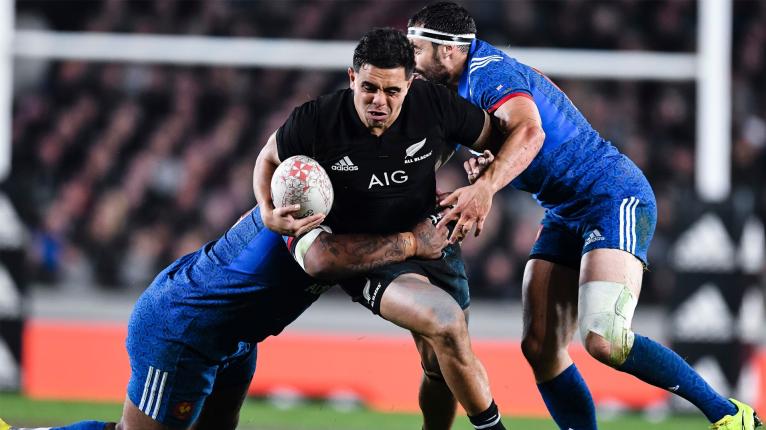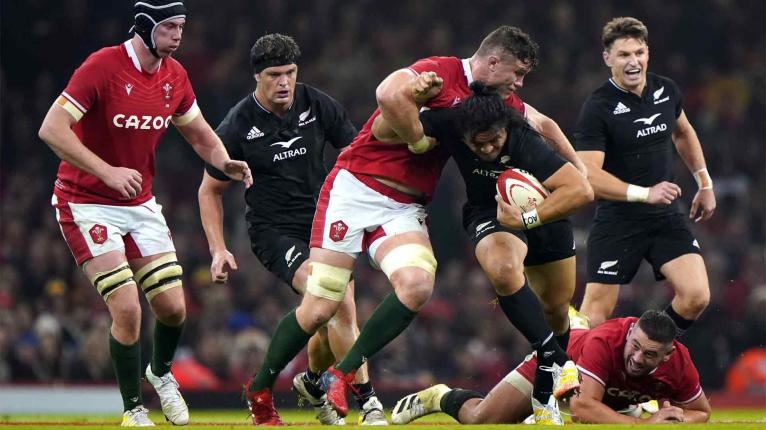After a run of successive matches on the left flank, Caleb Clarke is suddenly set to face a considerably larger challenge to hold his spot in the All Blacks match-day squad.
The 23-year-old burst onto the scene for New Zealand during their shortened 2020 campaign, coming into the side for the injured George Bridge, and he made every post a winner.
While his speed in the outer channels gave the All Blacks a new attacking threat in the mould of Rieko Ioane, Joe Rokocoko or Sitiveni Sivivatu, it was his power and ability under the high ball that made him such a useful exponent on the wing.

Clarke couldn’t just run through space, he could create it – and if the young outside back could bring a passing and offloading game into his toolbox, he’d be almost impossible to defend. Clarke was clearly not yet the finished product, often struggling to find supporting runners or choosing to hold onto the ball and take on a defender on his own when a simple pass would have produced the greatest outcome for his side, but the raw materials were all there to create a once-in-a-generation player.
Two years on, and Clarke’s career hasn’t exactly stagnated but it’s also not yet taken flight.
2021 was a write-off for the outside back, with injuries hampering Clarke’s Super Rugby season and an ill-fated stint with the national sevens side preventing him from featuring for the All Blacks throughout their mammoth 15-match campaign.
2022 has been a different story, however, with Clarke one of the form wingers throughout Super Rugby Pacific. A hamstring injury prematurely ended his campaign with the Blues – and prevented him from taking the field in New Zealand’s first two Tests of the season, but Clarke has since been a permanent selection on the left wing since and rarely put a foot wrong.
Lienert-Brown, who spent the first half of the Test calendar sidelined through injury, is New Zealand’s most experienced midfielder; behind centurions Aaron Smith and Beauden Barrett, he’s the most experienced player in the backline.
His distribution game still requires work, his link play remains a work-on and his defence has let him down at times, but Clarke’s effectiveness throughout the year can’t be denied.
And yet, the blockbusting young winger is at threat of losing his spot not just in the starting XV but in the match-day 23 altogether.
That’s thanks, in part, to the return from injury of Anton Lienert-Brown.
Lienert-Brown, who spent the first half of the Test calendar sidelined through injury, is New Zealand’s most experienced midfielder; behind centurions Aaron Smith and Beauden Barrett, he’s the most experienced player in the backline – and coach Ian Foster will be well aware that Lienert-Brown can help reinvigorate the All Blacks’ at times stuttering attack while also shoring up the defence.
In Lienert-Brown’s absence, David Havili and Rieko Ioane have been the preferred options in the centres, combining on six occasions throughout the season to date. While the partnership has never quite clicked, that’s perhaps more a product of the tactics employed by the All Blacks rather than the individual merits of the two players concerned.

Jordie Barrett has also recently emerged as a genuine option in the No 12 jersey and his sizeable frame makes him the perfect man to carry out Foster’s crash-and-bash tactic. Lienert-Brown’s return (as well as the presences of Roger Tuivasa-Sheck and Braydon Ennor) creates a midfield headache for Foster and it could be that the greatest benefit could come from fielding all three of Barrett, Lienert-Brown and Ioane in the three-quarters roles – but three players don’t fit into two positions.
Ioane, of course, made a name for himself as a left winger – and it could be that’s the position he returns to when everyone is finally fit and firing.
While Clarke has been a handy ball-carrying presence in the wider channels, Ioane has been the All Blacks’ best back throughout the season and found his mojo again after going through a relative form slump in the build-up to the last Rugby World Cup.
If Ioane does return to the wing – as he did in the final stages of the most recent win over Wales, that leaves Clarke fighting it out with the likes of Will Jordan and Sevu Reece for the other spot in the outer channels – and that’s not necessarily a battle where he’ll come out trumps.
Make no mistakes, Clarke is a classy winger who could challenge for ‘best in the world’ status with more matches under his belt, but Jordan and Reece are perhaps more complete packages at this stage of their careers.
The three-quarters combined for little more than a dozen touches in the humid affair at Cardiff, with Clarke contributing one pass and four runs for 12 metres – as well as a couple of drops.
Lienert-Brown won’t return to the starting centre role immediately but it’s an inevitable change that will come once the 27-year-old is able to get more than just a handful of minutes under his belt – perhaps as early as this weekend’s Test in Edinburgh. That doesn’t leave Clarke with much time to prove he’s a better wing option than his compatriots.
Saturday’s clash with Wales marked Clarke’s first game against Northern Hemisphere opposition and he had few opportunities to reinforce his claim on the No 11 jersey.
The three-quarters combined for little more than a dozen touches in the humid affair at Cardiff, with Clarke contributing one pass and four runs for 12 metres – as well as a couple of drops. It wasn’t a convincing display – but Foster acknowledged that the conditions didn’t exactly allow for sweeping backline moves.
“It was the nature of the conditions last night,” he said on Sunday. “It was very slippery. I think it would have been better conditions to play in if the roof was open, quite frankly. It wouldn’t have been better for the spectators but I think the condensation and the atmosphere just made it an extremely slipper game.
“So I actually quite like that stat, to be fair, in that sort of game, because sometimes we overplay in those conditions because we just want to play and I kind of like the patience.”

While it might have been smart from the All Blacks, it didn’t give Clarke any opportunities to advance his case and that could prove significant down the line.
The truth of the matter is that while the 23-year-old has put in some competent displays against other opposition, he’s really only stood out in games against Australia. While that’s a good kick-off point, it’s hardly the kind of consistency that is going to justify his selection against the likes of France, Ireland or South Africa at next year’s World Cup.
With Will Jordan remaining in New Zealand due to an inner ear problem, Clarke is still due to play at least one more match on the All Blacks’ end-of-year tour and while he certainly won’t be discarded by the national side anytime soon, his continued selection in the No 11 jersey is certainly not a given – not when there are other hungry outside backs waiting in the wings.



Why are media pundits always pushing for changes. Stability is needed. We ran up 55 what more do they want. Jordie and RIeko should be a lock now until 2023 RWC wraps up. Clarke is a bit of a liability on defense tackling wise but his aerial game and running are excellent he will get better on the tackling, it's not a natural skill issue just a technical one. Stick with him he is in the tradition of BG and other great left wings we have had he will carve up Scotland if they get the conditions.
I would rather see Stevenson get a shot.
Clarke decided that he wanted a sevens gold medal instead of concentrating on the All Blacks. It showed that Clarke doesn't value the All Blacks jersey enough.
Too many of Clarke's defensive reads are so bad they basically set up a try for the opposition. He has the running and aerial skills but needs to develop an all-around game. If he does, he will be an awesome player.
Will Jordan and Shaun Stevenson would be interesting as the ABs wingers? That’s some attacking potency.